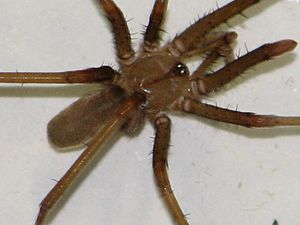Southern house spider facts for kids
Quick facts for kids Southern house spider |
|
|---|---|
 |
|
| Scientific classification | |
| Synonyms | |
|
Filistata hibernalis |
The southern house spider is a large spider found across the Americas. Its scientific name is Kukulcania hibernalis. These spiders live in the southern United States, throughout Central America, some parts of the Caribbean, and down to southern Brazil, Uruguay, and Argentina.
Male and female southern house spiders look quite different from each other. This is called sexual dimorphism.
Contents
What They Look Like
Male southern house spiders can sometimes be confused with brown recluse spiders. This is because they have similar colors and body shapes. However, male southern house spiders are usually bigger. They also do not have the violin shape on their cephalothorax (the front part of their body). Plus, their pedipalps (small leg-like parts near their mouth) are unusually long and thin.
Female southern house spiders are dark brown or black. They have a more compact body shape. Both male and female spiders can grow to be about 5 centimeters (2 inches) across, including their legs. Males usually have longer legs, while females often have larger, rounder bodies. The spider's abdomen is covered with soft, light gray hair, making it look velvety.
Where They Live and How They Move
Female southern house spiders are rarely seen. They build their webs in a radial (spoke-like) pattern around cracks and holes. Because of this, their spider family (Filistatidae) is known as crevice weavers. Females do not move much, only leaving their web to catch prey.
Males, on the other hand, are often seen wandering around. They search for insects to eat and females to mate with. They do not have a specific territory.
How They Catch Food
The southern house spider is a cribellate spider. This means its spinnerets (the parts that make silk) do not produce sticky web silk. Instead, to catch food, the spider uses its legs to comb silk across a special plate called a cribellum. This plate is located near its spinnerets.
This combing action makes the silk strands fray and tangle. The result is a fine, velcro-like net. This net is perfect for trapping the legs of insects, making them unable to escape.
Are They Dangerous?
Male southern house spiders might seem aggressive sometimes. However, they usually do not bite unless they feel trapped. Even if they do try to bite, their mouthparts are too small to easily break human skin.
These spiders have a strange habit of crawling over anything in their path, even if it is a person. This is not because they are aggressive. It is because they are almost blind and cannot see larger animals very well. If these spiders feel threatened, they will often pretend to be dead. This trick works well against the animals that usually hunt them.
Southern house spiders have long bodies and compact legs. This allows them to crawl through very narrow cracks, as small as 0.66 centimeters (1/4 inch) wide.
Reproduction
The mating process for southern house spiders is long and detailed. It can last for over an hour. During this time, both the male and female may stay very still for long periods.
When a wandering male finds a female's web, they might first scare each other. After they calm down, the male builds a large web around the female's crevice. Once his web is finished, the male pulls on its strands again and again. He does this to get the female to come out of her hole, which can take several minutes. After she comes out, both spiders will tap each other. They try to grab each other by their front legs, with the male still hanging in his web.
See also

- In Spanish: Kukulcania hibernalis para niños

